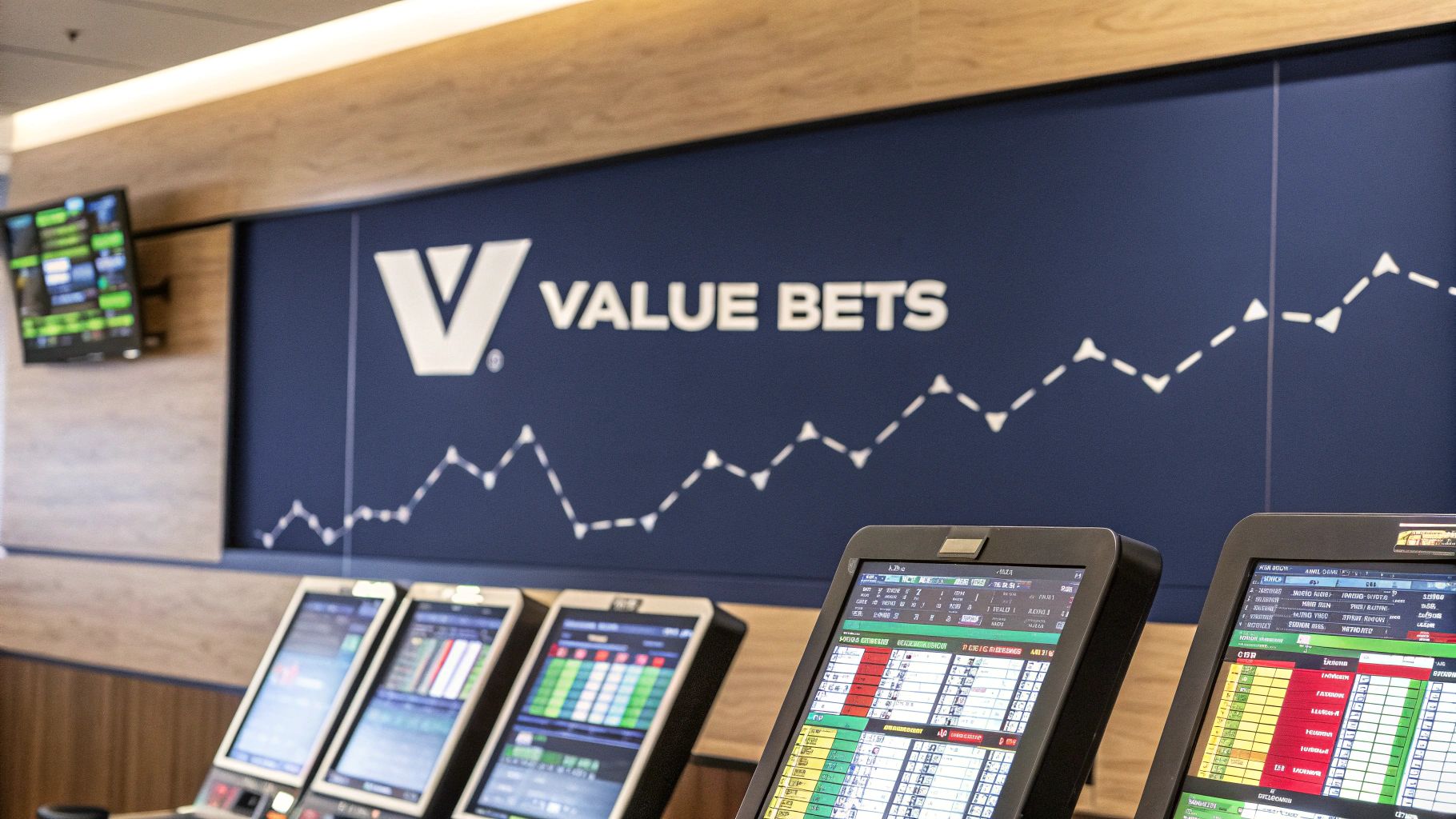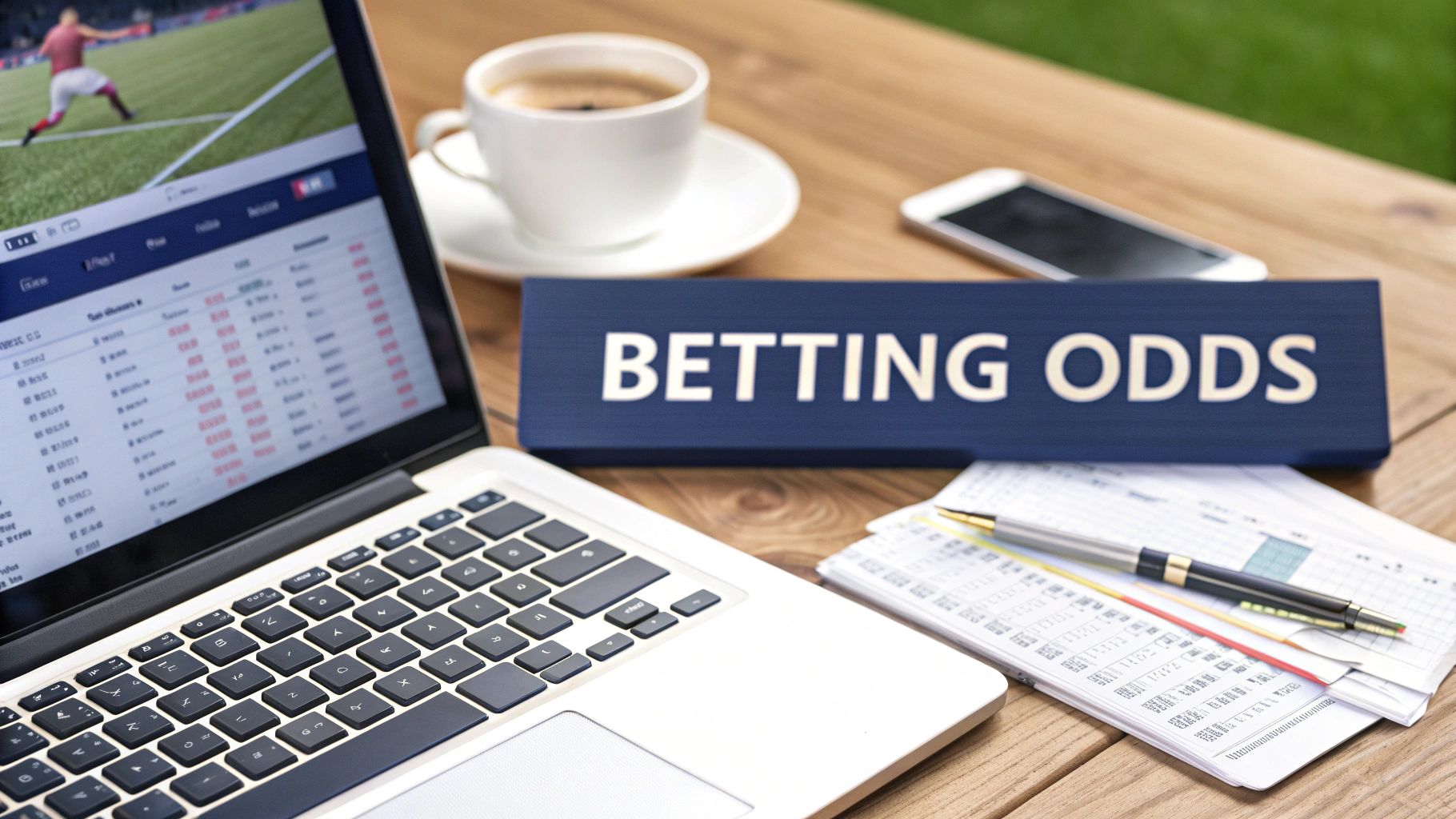
How to Read Betting Odds a UK Bettor's Guide
Unlock the secrets of sports betting. This guide explains how to read betting odds in fractional, decimal, and American formats with real-world examples.
Getting your head around betting odds is actually simpler than it looks. At their core, odds tell you two things: the bookmaker's estimated chance of something happening, and what you’ll get paid if you're right. For most of us in the UK, that means looking at fractional odds like 5/1, but you'll see decimal odds (e.g., 6.00) all over the internet. Nailing this skill is the first real step toward placing smarter, more confident wagers.
Your Quick Guide to Reading Betting Odds
Before we get into the nitty-gritty, let's set the stage. Betting odds are just the bookie's way of showing probability, but they also lock in your potential winnings. The three main flavours—Fractional, Decimal, and American—all say the same thing, just in a different dialect. While fractional odds are the classic choice here in the UK, a lot of online bookies and seasoned punters lean towards decimal odds because they make calculations a breeze.
Knowing how to switch between these formats in your head is a game-changer. You don't want to pass up on a great value bet just because it's listed in a format you're not used to seeing.
Comparing Odds Formats at a Glance
Sometimes, seeing them side-by-side is all it takes for the penny to drop. Think of each format as a different language telling the same story of risk and reward. Let's see how they translate.
This infographic is a great visual cheat sheet for understanding how the different formats work.
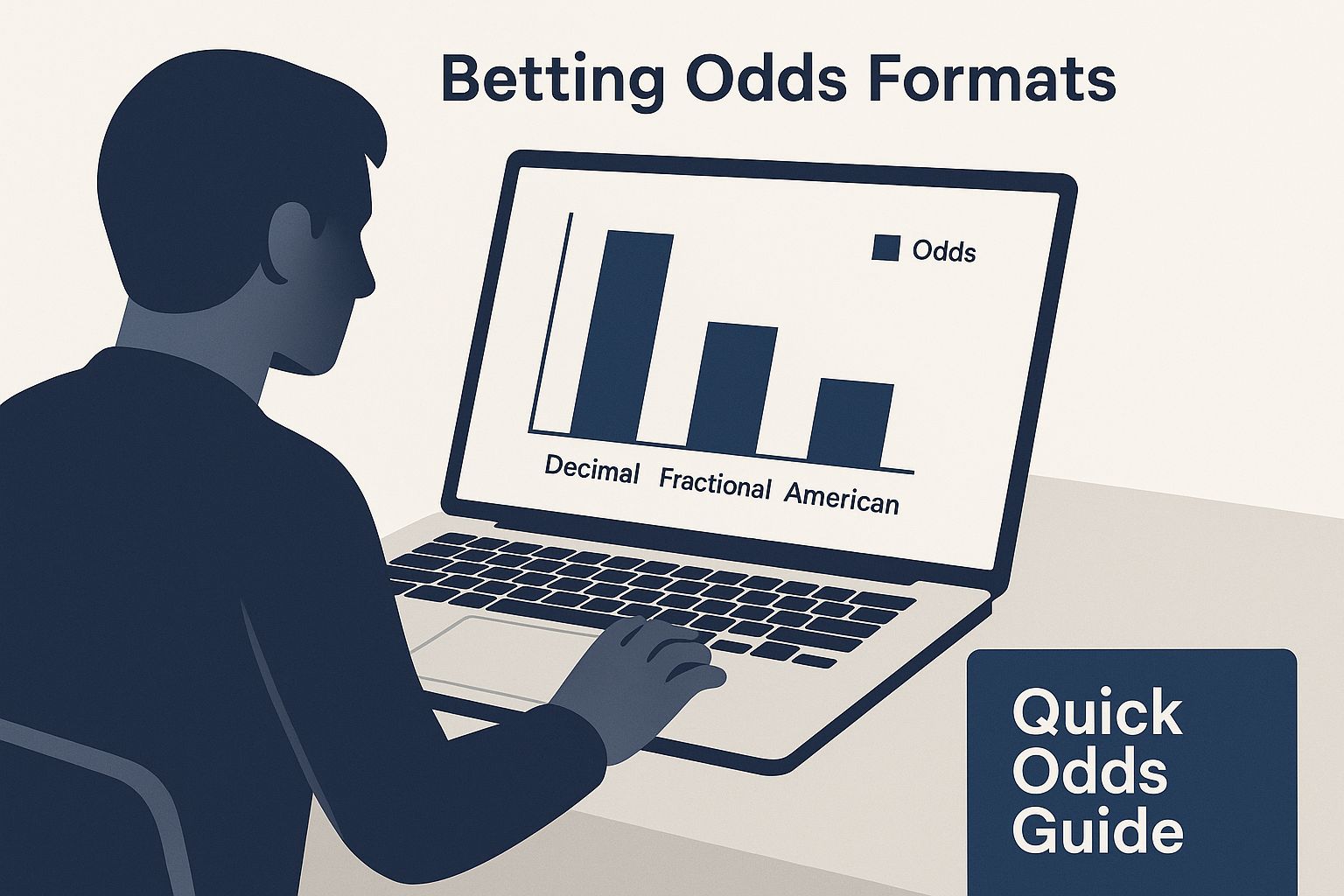
It really shows how different numbers can point to the exact same probability and potential return on your stake.
To break it down even further, here’s a quick reference table showing how the three main odds types handle the same bet with a £10 stake. Think of it as your go-to translator.
Betting Odds Format Comparison
| Odds Format | Example | Winnings on a £10 Bet | Total Payout | Implied Probability |
|---|---|---|---|---|
| Fractional (UK) | 5/1 | £50 | £60 | 16.7% |
| Decimal (European) | 6.00 | £50 | £60 | 16.7% |
| American (Moneyline) | +500 | £50 | £60 | 16.7% |
As you can see, a 5/1 fractional bet, a 6.00 decimal bet, and a +500 American bet all deliver the exact same £50 profit on your tenner.
Getting comfortable with this is your ticket to finding value on any betting site, no matter how they choose to display their odds. It puts you in control.
Mastering Fractional Odds: The UK Favourite
If you've ever stepped into a high-street bookie or had a flutter on the Grand National, you’ll recognise fractional odds. They’re the bread and butter of British betting, and getting to grips with them is absolutely essential for anyone serious about making a profit. You'll see them written as a fraction, like 4/1 or 1/2, and they tell you one simple thing: how much you’ll win for what you stake.
Think of it this way: the number on the left is your potential profit, and the number on the right is your stake. So, with odds of 4/1, you’ll pocket £4 in profit for every £1 you put down. Straightforward, isn't it?
But it’s when those numbers flip that you can really start to separate the pros from the casual punters.
Odds-On vs Odds-Against Explained
Not every bet is a longshot destined for a massive payout. Often, you’re backing a team or a horse that's heavily fancied to win, and that’s where you’ll run into 'odds-on' prices.
- Odds-Against (e.g., 4/1, 9/2): This is your classic underdog scenario. The potential profit is bigger than your stake. A £10 bet at 4/1 doesn't just return £40; you get your £10 stake back too, for a total of £50 in your hand.
- Odds-On (e.g., 1/2, 2/5): Here, you’re backing a strong favourite. Your potential profit is actually less than what you risk. To win just £1 at odds of 1/2, you have to stake £2. So, a £10 bet gets you £5 profit, for a total payout of £15.
It’s the age-old trade-off between risk and reward. Backing an odds-on favourite feels like a safer bet, but remember, you're putting more on the line for a smaller return.
From Fractions to True Probability
Now, here's the skill that separates the successful bettors from everyone else: turning those fractions into a percentage. This reveals what the bookmaker truly thinks the chances of an outcome are, and it’s the first step towards finding genuine value.
The formula for converting fractional odds (A/B) to their implied probability is beautifully simple: Probability (%) = B / (A + B) * 100
Let's put this into practice with a proper Premier League example. Say Arsenal are hosting Crystal Palace.
The bookie has Arsenal priced at 1/2 to win. Let's run the numbers: (2 / (1 + 2)) * 100 gives you 66.7%. In the bookmaker's eyes, they're the overwhelming favourites.
Meanwhile, Crystal Palace are the outsiders at 4/1. That calculation is: (1 / (4 + 1)) * 100, which works out to just 20%. The odds tell a story of a likely home win.
By doing this quick calculation, you're no longer just staring at potential payouts. You’re starting to analyse the game. You can now compare the bookie's assessment against your own knowledge. What if you've done your homework and reckon Palace's real chances are closer to 30%? Suddenly, those 4/1 odds don't just look long; they look like fantastic value. And that, right there, is the heart of smart betting.
Getting to Grips with Decimal and American Odds
While fractional odds are the bread and butter of the UK betting scene, the moment you step online or onto a betting exchange, you'll run into decimal and American odds. Getting your head around these is essential if you want to hunt down the best prices across the global market. Don't let an unfamiliar number format scare you away from a great value bet.
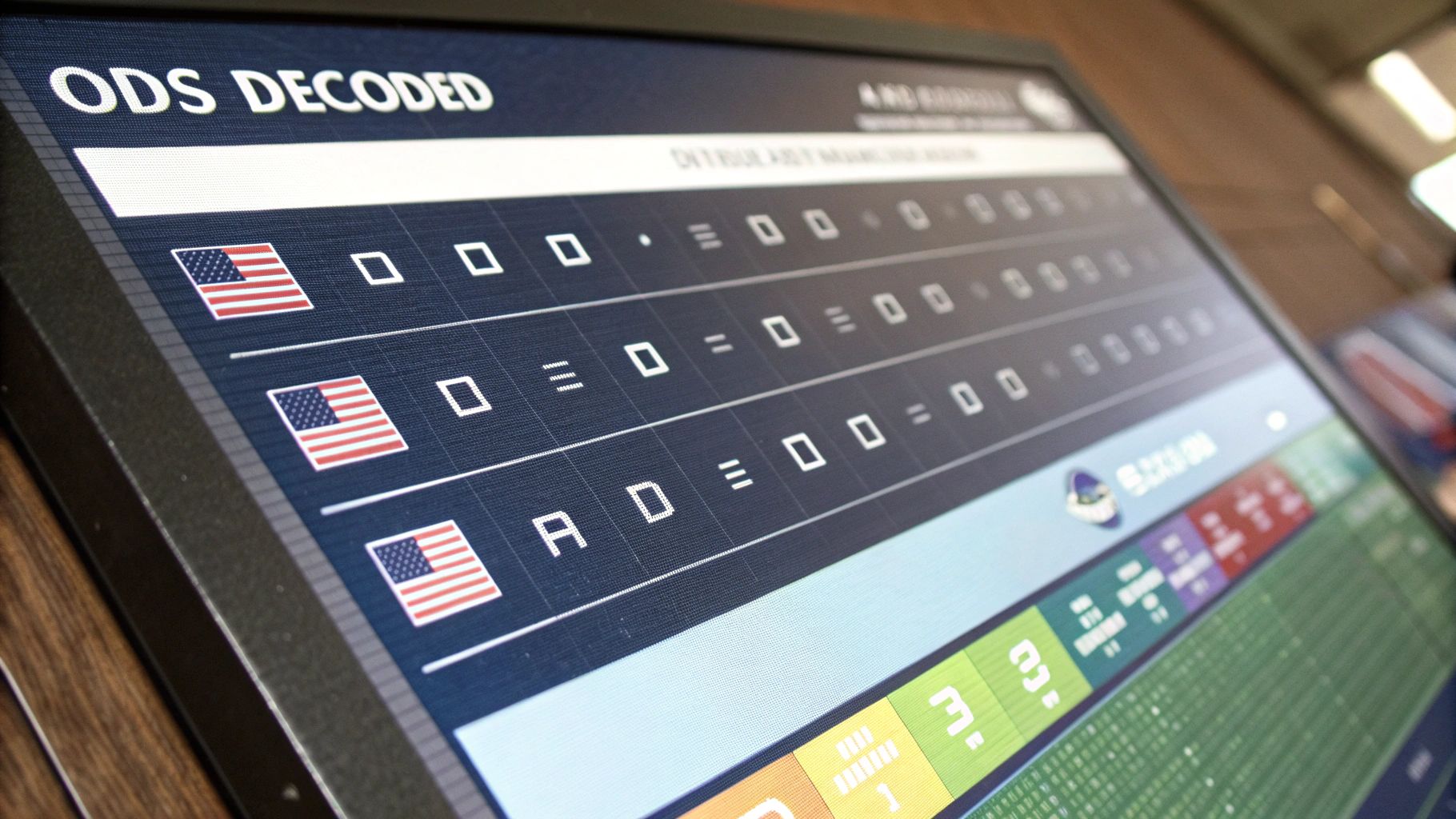
In fact, a lot of experienced punters I know actively prefer decimal odds. Why? Pure simplicity. They are, without a doubt, the most direct way to understand your potential return, which is why they're standard across Europe and on all the major betting exchanges.
The Simplicity of Decimal Odds
Decimal odds, like 2.50 or 4.00, tell you the total payout you’ll receive for every £1 you stake. Crucially, this figure includes your original stake. The calculation couldn't be easier: Stake x Decimal Odds = Total Payout.
Let's go back to that 4/1 bet on Crystal Palace. In decimal format, this is simply 5.00. A £10 stake at 5.00 gets you a total return of £50 (£10 x 5.00) – that’s your £40 profit plus your £10 stake returned. There’s no need to add your stake back on mentally; the number does all the heavy lifting.
The magic number with decimal odds is 2.00, which is the equivalent of "evens" (1/1). Anything below 2.00 is 'odds-on' (the favourite), and anything above it is 'odds-against' (the underdog). This makes spotting favourites and longshots in a list completely effortless.
Understanding American Odds
Though you won't see them as often in the UK, you’ll definitely encounter American (or 'moneyline') odds on US-focused sports sites. They look a bit strange at first, using positive (+) and negative (-) signs to show who the favourite is.
Everything revolves around the number 100.
- Positive Odds (+): This figure shows how much profit you’ll make from a £100 stake. So, odds of +300 mean you’d win £300 profit for every £100 you bet. These are always for the underdog.
- Negative Odds (-): This tells you how much you must stake to win £100 in profit. Odds of -150 mean you need to risk £150 just to win £100. This is the mark of the favourite.
So, our 4/1 Crystal Palace longshot would be shown as +400 in American odds. It instantly tells you a £100 punt would bring in £400 profit. On the flip side, Arsenal’s 1/2 odds would translate to -200, meaning you'd have to stump up £200 to make a £100 profit.
While you probably won't use them every day, knowing how to read these formats means you’re never caught off guard. Most modern betting platforms, including the OddsHaven app, let you toggle between formats with a click. But true fluency in all three is the sign of a savvy, well-rounded punter. It gives you the confidence to compare odds across any bookmaker or exchange without a moment's hesitation.
Unlocking the Secret Language of Odds: Finding Real Value
Right, this is where the real game begins. It's the moment you stop just reading odds and start understanding what they're actually telling you. Those numbers aren't just about how much you could win; they're a direct signal from the bookmaker about what they think the chances are of something happening.
This is what we call implied probability, and getting your head around it is the absolute key to betting smart.
Calculating implied probability takes the odds and turns them into a simple percentage. Suddenly, you have a concrete number to work with, stripping away the clutter of different formats and showing you exactly where the bookie has drawn their line in the sand.
Turning Odds into Percentages
The best part? The maths behind this is dead simple, no matter what kind of odds you're looking at. You don't need a degree in statistics, just the right formula for the job.
Here's how you do it:
- Fractional Odds (e.g., 4/1): The formula is Denominator / (Numerator + Denominator) x 100. For a 4/1 shot, the calculation is 1 / (4 + 1) x 100, which gives you 20%.
- Decimal Odds (e.g., 5.00): This one is even easier. It's just (1 / Decimal Odds) x 100. So, for 5.00, that's simply (1 / 5.00) x 100 = 20%.
Let's say you're looking at a team priced at 7/2. A quick bit of maths—2 / (7 + 2) x 100—tells you the bookie is giving them a 22.2% chance. Now you have a clear figure you can actually work with and challenge.
The entire philosophy of value betting boils down to one simple idea: find a mismatch between the bookmaker's implied probability and what you believe the true probability is. If you think the real chance is higher than the odds suggest, you've just found a value bet.
This is the mental shift that separates casual punters from genuine sharps. You stop asking, "Who's going to win?" and start asking, "Do these odds offer good value for the risk I'm taking?"
How to Spot Your Own Value Bets
So, how do you actually form your own opinion and decide when the bookie has got it wrong? It all starts with your own knowledge, research, and data you can get your hands on. You're not trying to build a complex algorithm; you're just looking for bits of information the odds might not be fully accounting for.
It could be anything. Maybe a star player is making a surprise return from injury, or perhaps you've noticed a team has a brilliant track record when playing in the rain.
A fantastic way to do this is by digging into historical data. Part of understanding betting odds in the UK is knowing how past results can shape current prices. For example, looking at archived data on a site like OddsPortal can help you spot trends you'd otherwise miss. To get a better grip on this, you should check out our guide on how to spot value bets and understand odds movement. This kind of analysis can reveal profitable patterns by comparing what happened in the past with the odds that were offered at the time.
Ultimately, it comes down to this: if your own analysis tells you a team has a 30% chance of winning, but the odds only imply a 22.2% chance, that 7.8% difference is your edge. That’s the value.
Of course, it doesn't mean you'll win every single time. But if you consistently place bets where you've found that edge, you're playing the long game – and that's the most proven way to come out ahead.
What’s Really Moving the Odds? It’s Not Just About Form
Ever seen the odds for a team suddenly plummet just hours before a match and wondered what’s going on? It’s rarely a single thing. A complex mix of factors is constantly at play behind the numbers, and getting a feel for these is what separates casual punters from sharp bettors.
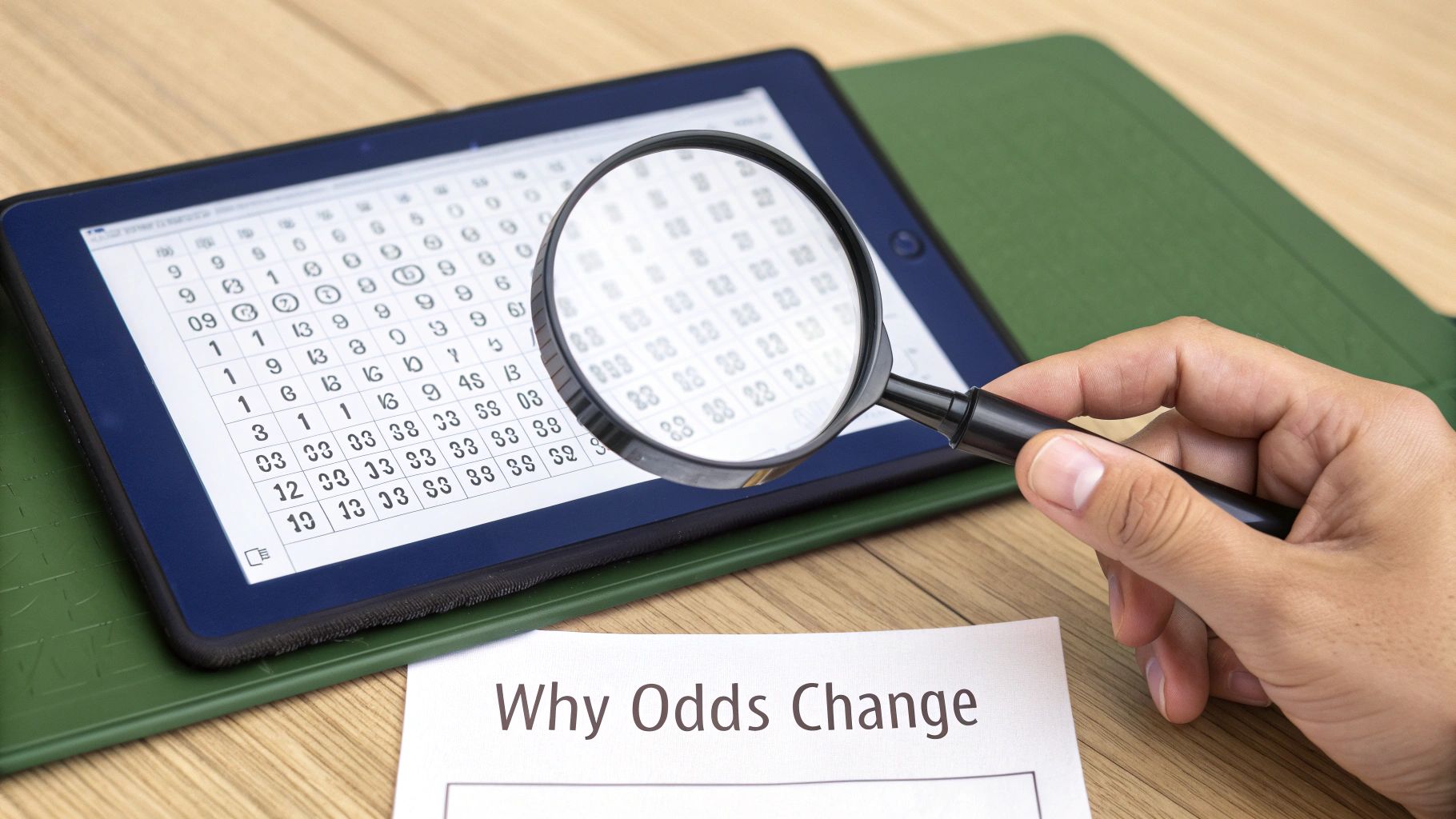
At its core, a bookmaker's goal isn't to predict who will win. Their main priority is to guarantee themselves a profit, no matter the final score. They do this with what’s known as the ‘bookmaker’s margin’ or ‘overround’.
Think of it as a small, built-in commission. This margin ensures that the implied probabilities of all outcomes in a single event add up to more than 100%. That slice above 100% is where the bookie makes their money. It's the reason you can’t just find two bookies with different odds and lock in a profit—the margin is there to stop you.
Public Money and Market Sentiment
Beyond the bookie’s margin, the single biggest driver of odds movement is what we call market sentiment. In simple terms, it's the weight of public opinion, shown through the flow of money. The odds you see aren't a pure reflection of probability; they're also a reaction to where the cash is going.
Imagine a flood of bets pours in on one team. This creates a huge liability for the bookmaker if that team wins. To rebalance their books and minimise risk, they have to react.
- They’ll shorten the odds on the heavily backed team to make it less attractive.
- At the same time, they’ll lengthen the odds on the other side to encourage bets and spread the money out.
This constant balancing act means the odds are a fascinating mix of hard stats and basic supply and demand. The real skill is learning to spot when odds have shifted because of media hype or public bias, rather than a genuine change in a team's winning chances.
A classic example is a big televised match. Popular, well-known teams often see their odds artificially shortened simply because of the sheer volume of casual bets placed on them. This can create fantastic value on the underdog.
The Bigger Picture
It’s also important to remember that bookmakers don’t operate in a vacuum. They're part of a massive financial ecosystem, and wider trends in the UK betting industry can have a ripple effect on the odds. For example, things like shifts in Pool Betting Duty receipts—which hit £9.0 million in the 2023-2024 financial year—signal changes in punter behaviour and regulations that bookies must adapt to. You can dig into the numbers and learn more about these financial trends in the UK betting industry to understand how the market is shaped.
Ultimately, odds are alive. They react instantly to everything from a last-minute injury report to a sudden surge of wagers. Learning to read these movements tells you a story about what the market is thinking. Our guide on using real-time odds tracking shows you how to turn this insight into a real edge and pounce on value the moment it appears.
Putting Your Knowledge into Practice
Alright, so you’ve got the theory down. You can read decimal, fractional, and American odds without breaking a sweat. But here’s the thing: understanding the language is just the start. The real skill—the part that separates casual punters from sharp bettors—is using that knowledge to find an edge.
It’s time to move beyond gut feelings. Successful betting today is all about using readily available data to build a more accurate picture of an event than the one the bookmaker is selling you.
Building a Data-Informed View
This doesn't mean you need a PhD in statistics or a supercomputer in your spare room. The core idea is simple: challenge the bookie's implied probability with your own analysis. When you can do that effectively, you start spotting those juicy discrepancies where the real value is hiding.
A great starting point is to build a basic probability model using historical data. Look at past results, how teams perform under certain conditions (like away from home or against a specific style of play), and their head-to-head records. This helps you form an opinion on an outcome's likelihood that's completely independent of what the odds are telling you.
Of course, you can take it a lot further. In the UK, many serious bettors use statistical tools and even Monte Carlo simulations. These models can run a single football match thousands of times to map out a whole range of potential outcomes, giving a much deeper view of probability. If you’re curious about this advanced stuff, football-data.co.uk offers some great insights into statistical models.
The goal isn't to be a fortune teller. It's about consistently finding bets where the odds are more generous than the actual probability of it happening. That’s the absolute bedrock of any long-term, winning strategy.
When you combine your ability to read odds with this kind of analytical mindset, you’re no longer just guessing. You're making calculated decisions. This is exactly where a tool like OddsHaven comes in, as our systems do this heavy lifting for you, running the numbers to pinpoint where the data suggests value lies. You can get the full story on how we use AI to make smarter bets in our dedicated guide.
Making this shift is what transforms betting from a bit of fun into a disciplined, and hopefully profitable, pursuit.
Your Betting Odds Questions, Answered
Once you get your head around the basics, a few common questions always seem to pop up. Don't worry, it's completely normal. Betting has its own language, and mastering it takes a bit of time. Let's tackle some of the most frequent queries from punters in the UK.
What Does 'Evens' Mean in Betting?
You'll definitely come across odds of 1/1 (or 2.0 in decimal), a price known simply as 'evens'.
Think of it as a straight 50/50 proposition. It means your potential profit is the exact same amount as your stake. So, a £10 bet at evens gets you £20 back – your £10 stake returned, plus £10 in pure profit. It represents a 50% chance, at least on paper, though the bookie's margin means the true probability is always a touch lower.
Why Are the Odds Always Changing?
If you've ever watched the odds for a match, you'll know they're anything but static. They fluctuate constantly, and it’s usually down to two main things:
- The Weight of Money: Imagine a flood of bets coming in for one team to win. To protect themselves from a massive payout, the bookies will shorten those odds and, in turn, lengthen the odds for the other outcome to encourage bets on that side. It's all about balancing their books.
- New Information: Breaking news is a massive odds-shifter. A star striker suddenly ruled out with an injury, a sudden downpour changing pitch conditions, or a surprise team sheet can all cause the odds to change in a heartbeat.
Think of the odds as a live, breathing market. They're constantly reacting to supply and demand (the money) and any new information that could sway the outcome of the event.
How Can I Tell If Odds Are Good Value?
This is the golden question, and mastering it is what separates casual punters from sharp, successful bettors. Finding value isn't just about picking winners; it's about finding odds that are bigger than they should be.
It all boils down to comparing the bookie's implied probability with your own, more informed assessment. For example, if you've done your homework and believe a team has a genuine 40% chance of winning, but the bookmaker's odds of 2/1 only suggest a 33.3% chance, you've spotted a value bet. That's where your knowledge gives you the edge.
Ready to turn your knowledge into confident decisions? OddsHaven uses AI to analyse thousands of data points, finding value bets so you don't have to. Start making smarter choices today at https://www.oddshaven.ai.
Ready to Start Winning?
Join OddsHaven and get instant access to AI-powered predictions with an 87% win rate on high-confidence picks
Try OddsHaven Free for 5 Days
